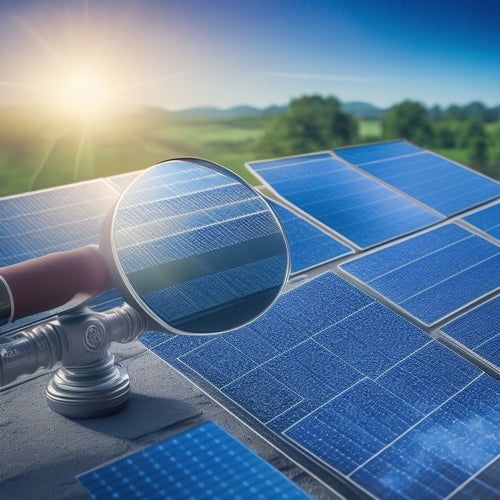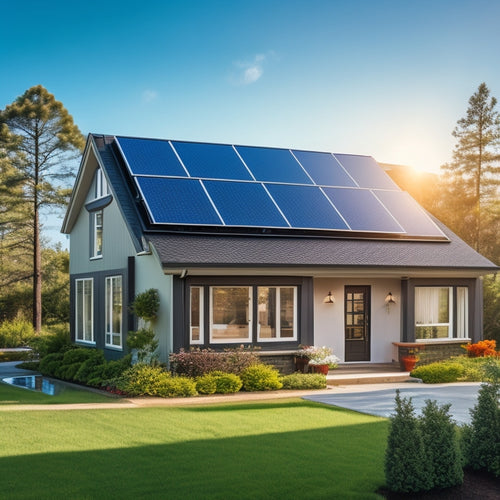
Optimizing System Size for Small Homes: 3 Essential Tips
Share
You start by accurately determining your home's energy needs, which sets the foundation for optimizing your system size and guaranteeing you get the most out of your investment. Next, consider your roof's physical constraints and potential obstruction issues to visualize the most efficient panel placement. Finally, strike a balance between upfront costs and long-term energy rewards by weighing priorities and investing in high-efficiency panels. By following these three essential tips, you'll be well on your way to a perfectly sized system for your small home - and there's more to explore to make sure you maximize your energy output.
Key Takeaways
• Determine total daily energy expenditure in watt-hours to accurately size the solar panel system for small homes.
• Conduct an energy audit to identify energy-hungry appliances and habits, and prioritize energy-efficient upgrades.
• Consider roof size constraints, including physical limitations and obstruction analysis, to visualize roof space strategically.
• Balance cost and efficiency by making system trade-offs based on budget priorities and investing in high-efficiency panels.
• Visualize energy goals to find the sweet spot between cost and efficiency, and prioritize energy usage patterns for maximum output.
Assessing Energy Needs Accurately
To accurately size a system for your small home, you must first determine your energy needs by calculating your total daily energy expenditure in watt-hours (Wh), an important step that sets the stage for a reliable and efficient system. Think of it like planning a road trip – you need to know how much fuel you'll need to reach your destination.
Conducting an energy audit is an essential step in this process. It's like taking inventory of your home's energy-hungry appliances and habits. You'll need to account for everything from your fridge's constant hum to your TV's occasional binge-watching sessions. This will give you a clear picture of your energy usage patterns.
Next, you'll perform load calculations to determine the maximum amount of energy your system needs to produce. This is where the math gets real – you'll need to crunch numbers to determine the total wattage required to power your home. Don't worry, it's not as intimidating as it sounds! With the right tools and a bit of patience, you'll be well on your way to sizing your system like a pro.
Considering Roof Size Constraints
Having a clear understanding of your energy needs, you'll need to take into account the physical constraints of your roof, as its size and orientation will greatly impact the number of solar panels you can accommodate. The size of your roof will dictate the maximum number of panels you can fit, while its orientation will affect the amount of sunlight those panels will receive.
Roof Angle Considerations come into play here, as a steeper angle can increase energy production, but may also increase installation costs.
Next, conduct an Obstruction Analysis to identify any obstacles that could cast shadows on your panels, such as trees, chimneys, or skylights. This will help you determine the most efficient layout for your solar array. Visualize your roof as a puzzle, and think strategically about how to maximize your space.
Balancing Cost and Efficiency
How can you strike a balance between minimizing upfront costs and maximizing energy efficiency when designing your solar panel system? It's a delicate dance, where every step counts.
You want to harness the power of the sun without breaking the bank. The key lies in identifying your priorities. What's more important to you: saving money upfront or reaping long-term energy rewards?
When making system trade-offs, consider your budget priorities. Are you willing to invest in high-efficiency panels for greater energy output, or do you prioritize keeping initial costs low? Perhaps you'll opt for a mid-range solution, sacrificing some efficiency for a more affordable price tag.
Visualize your energy goals: do you want to offset a portion of your energy consumption or aim for total independence from the grid? By weighing these factors, you'll find the sweet spot where cost and efficiency converge.
Frequently Asked Questions
Can I Install a Solar System on a Shaded Roof?
You're wondering if a shaded roof is a solar system deal-breaker? Not necessarily! Conduct a shade analysis to identify roof obstructions, then determine the impact on energy production – it might be more feasible than you think!
How Often Should I Clean My Solar Panels?
"You'll want to clean your solar panels every 6-12 months to prevent dust accumulation, which can reduce energy output by up to 25%. Regular panel maintenance keeps your system running smoothly, and who doesn't love a sparkly clean roof?"
Are Energy-Efficient Appliances Compatible With Solar Power?
You're wondering if energy-efficient appliances are compatible with solar power? Absolutely! They're a match made in heaven, reducing your energy draw on the power grid and maximizing your solar setup's output - it's a win-win!
Do Solar Panels Work During a Power Outage?
You're wondering if solar panels save the day during a power outage? Sorry, they won't, unless you have a backup solution like a battery storage system, which guarantees grid resilience, keeping your lights on and your sanity intact.
Can I Expand My Solar System in the Future?
When you're wondering if you can expand your solar system in the future, the answer is yes! Future-proofing your system with scalable designs guarantees you can add more panels as your energy needs grow, making it a bright idea!
Related Posts
-

Solar Panel System Certification Costs: A 10-Point Breakdown
You're looking to understand the costs associated with solar panel system certification. Your total certification cos...
-

Planning for an Electric Vehicle-Friendly Urban Future
As you plan for an electric vehicle-friendly urban future, you'll need to integrate high-power charging stations, sma...
-

Solar Power Units Perfect for Homes
You're considering installing a solar power unit in your home, a decision that can notably reduce your reliance on tr...


